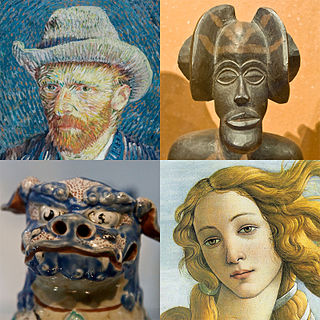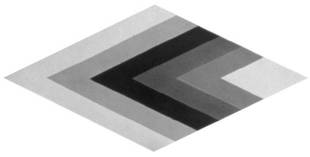Related Research Articles

Art is a diverse range of human activity and its resulting product that involves creative or imaginative talent generally expressive of technical proficiency, beauty, emotional power, or conceptual ideas.
Aesthetics is the branch of philosophy concerned with the nature of beauty and the nature of taste; and functions as the philosophy of art. Aesthetics examines the philosophy of aesthetic value, which is determined by critical judgements of artistic taste; thus, the function of aesthetics is the "critical reflection on art, culture and nature".

Performance art is an artwork or art exhibition created through actions executed by the artist or other participants. It may be witnessed live or through documentation, spontaneously developed or written, and is traditionally presented to a public in a fine art context in an interdisciplinary mode. Also known as artistic action, it has been developed through the years as a genre of its own in which art is presented live. It had an important and fundamental role in 20th century avant-garde art.
Richard Kern is an American underground filmmaker, writer and photographer. He first came to prominence as part of the cultural explosion in the East Village of New York City in the 1980s, with erotic and experimental films like The Right Side of My Brain and Fingered, which featured personalities of the time such as Lydia Lunch, David Wojnarowicz, Sonic Youth, Kembra Pfahler, Karen Finley and Henry Rollins. Like many of the musicians around him, Kern had a deep interest in the aesthetics of extreme sex, violence and perversion and was involved in the Cinema of Transgression movement, a term coined by Nick Zedd.
Bruce Barber is an artist, writer, curator, and educator based in Halifax, Nova Scotia, where he teaches at NSCAD University. His artwork has been shown at the Paris Biennale, the Sydney Biennial, the New Museum of Contemporary Art, the Walter Phillips Gallery, London Regional Gallery, and Artspace NZ in Auckland. Barber is the editor of Essays on Performance and Cultural Politicization and of Conceptual Art: the NSCAD Connection 1967–1973. He is co-editor, with Serge Guilbaut and John O'Brian of Voices of Fire: Art Rage, Power, and the State. His critical essays have appeared in numerous anthologies, journals and magazines. His art practice is documented in the publication Reading Rooms. He is best known for his early performance work, his Reading Rooms, Squat Projects and his writing and theory on Littoral Art.

Voice of Fire is an 1967 acrylic on canvas abstract painting made by American painter Barnett Newman in 1967. It consists of three equally sized vertical stripes, with the outer two painted blue and the centre painted red. The work was created as a special commission for Expo 67. In 1987 it was loaned to the National Gallery of Canada in Ottawa, Ontario, Canada.

The Theory of Communicative Action is a two-volume 1981 book by the philosopher Jürgen Habermas, in which the author continues his project of finding a way to ground "the social sciences in a theory of language", which had been set out in On the Logic of the Social Sciences (1967). The two volumes are Reason and the Rationalization of Society, in which Habermas establishes a concept of communicative rationality, and Lifeworld and System: A Critique of Functionalist Reason, in which Habermas creates the two level concept of society and lays out the critical theory for modernity.
Relational art or relational aesthetics is a mode or tendency in fine art practice originally observed and highlighted by French art critic Nicolas Bourriaud. Bourriaud defined the approach as "a set of artistic practices which take as their theoretical and practical point of departure the whole of human relations and their social context, rather than an independent and private space." The artist can be more accurately viewed as the "catalyst" in relational art, rather than being at the centre.

Fred Forest is a French new media artist making use of video, photography, the printed press, mail, radio, television, telephone, telematics, and the internet in a wide range of installations, performances, and public interventions that explore both the ramifications and potential of media space. He was a cofounder of both the Sociological Art Collective (1974) and the Aesthetics of Communication movement (1983).
Bruce Yonemoto and Norman Yonemoto are two Los Angeles, California-based video/installation artists of Japanese American heritage.

Systems art is art influenced by cybernetics, and systems theory, that reflects on natural systems, social systems and social signs of the art world itself.
NSCAD conceptual art refers to a period beginning in 1969 when Nova Scotia College of Art and Design (NSCAD), a post-secondary art school in Halifax, Nova Scotia, Canada became an important art centre with an international reputation.

The arts are a wide range of human practices of creative expression, storytelling, and cultural participation. They encompass multiple diverse and plural modes of thinking, doing, and being, in an extremely broad range of media. Both dynamic and a characteristically constant feature of human life, they have developed into innovative, stylized, and sometimes intricate forms. This is often achieved through sustained and deliberate study, training, and/or theorizing within a particular tradition, across generations, and even between civilizations. The arts are a vehicle through which human beings cultivate distinct social, cultural, and individual identities while transmitting values, impressions, judgements, ideas, visions, spiritual meanings, patterns of life, and experiences across time and space.
Ecological art is an art genre and artistic practice that seeks to preserve, remediate and/or vitalize the life forms, resources and ecology of Earth. Ecological art practitioners do this by applying the principles of ecosystems to living species and their habitats throughout the lithosphere, atmosphere, biosphere, and hydrosphere, including wilderness, rural, suburban and urban locations. Ecological art is a distinct genre from Environmental art in that it involves functional ecological systems-restoration, as well as socially engaged, activist, community-based interventions. Ecological art also addresses politics, culture, economics, ethics and aesthetics as they impact the conditions of ecosystems. Ecological art practitioners include artists, scientists, philosophers and activists who often collaborate on restoration, remediation and public awareness projects.
Fuse was a Toronto-based Canadian non-profit arts and culture periodical published by Artons Cultural Affairs Society and Publishing Inc. Fuse was one of Canada’s longest running alternative art publications. Throughout its 38 year history, the focus has been the interchange between art, media, and politics. The magazine published its final issue in Winter 2013, under the editorial direction of Gina Badger.
Feminist aesthetics first emerged in the 1970s and refers not to a particular aesthetic or style but to perspectives that question assumptions in art and aesthetics concerning gender-role stereotypes, or gender. Feminist aesthetics has a relationship to philosophy. The historical philosophical views of what beauty, the arts, and sensory experiences are, relate to the idea of aesthetics. Aesthetics looks at styles of production. In particular, feminists argue that despite seeming neutral or inclusive, the way people think about art and aesthetics is influenced by gender roles. Feminist aesthetics is a tool for analyzing how art is understood using gendered issues. A person's gender identity affects the ways in which they perceive art and aesthetics because of their subject position and that perception is influenced by power. The ways in which people see art is also influenced by social values such as class and race. One's subject position in life changes the way art is perceived because of people's different knowledge's about life and experiences. In the way that feminist history unsettles traditional history, feminist aesthetics challenge philosophies of beauty, the arts and sensory experience.

Vaporwave is a microgenre of electronic music and a subgenre of hauntology, a visual art style, and an Internet meme that emerged in the early 2010s, and became well-known in 2015. It is defined partly by its slowed-down, chopped and screwed samples of smooth jazz, 1970s elevator music, R&B, and lounge music from the 1980s and 1990s. The surrounding subculture is sometimes associated with an ambiguous or satirical take on consumer capitalism and pop culture, and tends to be characterized by a nostalgic or surrealist engagement with the popular entertainment, technology and advertising of previous decades. Visually, it incorporates early Internet imagery, late 1990s web design, glitch art, anime, stylized Greek sculptures, 3D-rendered objects, and cyberpunk tropes in its cover artwork and music videos.

Dalida María Benfield is a media artist, researcher, and writer. In Benfield's research-based artistic and collective practices, she produces video, installation, archives, artists' books, workshops, and other pedagogical and communicative actions, across online and offline platforms. She is currently faculty in the Vermont College of Fine Arts MFA in Visual Arts program, and was a Research Fellow and Faculty Associate at the Berkman Center for Internet and Society at Harvard University (2011–2015).
In art, resilience is the capacity of the work of art to preserve through aesthetics its particularity distinguishing it from any other object, despite the increasing subjectivization in the production of works. Resilience in art appears as a response to the gradual setting aside of beauty during the twentieth century resulting today in an inability to define the work of art.

Ontopoetics is a philosophical concept that involves the communicative engagement of self with the world and the world with the self. It is also described as a "poetic order" that unfolds alongside the "causal order" in the process of the communicative engagement with reality and participating in it. It includes the perception of cues or signals, or the expression of actors, as well as "the construction of impressions on re-actors by the deliberate choice of attractive signifiers that communicate factual or illusory realities".
References
- 1 2 Christine Ross, The Aesthetics of Disengagement: Contemporary Art and Depression, University of Minnesota Press, 2006, p138. ISBN 0-8166-4539-6
2. Barber, Bruce Littoral Art and Communicative Action edited by Marc James Leger, Common Ground Press, Illinois 2013